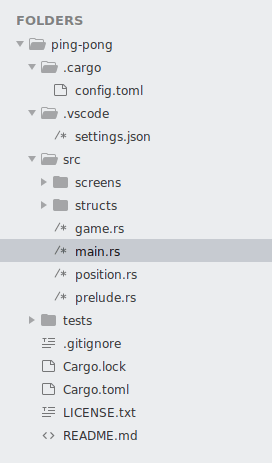Ping-Pong rust: a project for your first dev-job

Stacy Roll
Posted on November 15, 2023

If you're looking for your first job as a Rust developer and are considering a project for your professional portfolio, this option could be a great proposal.
Let's add the ping-pong repository created by Eduardo Moraes and analyze the code:
git clone https://github.com/EduLMoraes/ping-pong.git
cargo run --release
Project structure:
main.rs
mod prelude;
use crate::prelude::*;
fn main() {
loop{
let choice: String = menu();
if choice == "A".to_string() || choice == "a".to_string(){
let lines: i32 = 20; //var("LINES").expect("Erro ao coletar 'LINES'").trim().parse::<i32>().expect("Erro ao converter 'COLUMNS' pra inteiro");
let columns: i32 = 70; //var("COLUMNS").expect("Erro ao coletar 'COLUMNS'").trim().parse::<i32>().expect("Erro ao converter 'COLUMNS' pra inteiro");
let board: Vec<Vec<char>> = vec![vec![' '; columns as usize]; lines as usize];
let player: Player = Player::new();
let scoreboard: Scoreboard = Scoreboard::new();
let ball: Ball = Ball::new(lines, columns);
let mut machine: Player = Player::new();
machine.x = columns-2;
let is_player_win: bool = play(player, machine, ball, scoreboard, board);
if is_player_win {
winner();
}
else{
loser();
}
}
else if choice == "B".to_string() || choice == "b".to_string(){
instruct();
}
else{
break;
}
}
}
The code defines a main function where the program runs in an infinite loop. Inside the loop, it presents a menu to the user by calling the menu function. Based on the user's choice (A, B, or anything else), it takes different actions.
If the user chooses option A (or a), the program initializes variables for lines and columns, creates a game board represented by a vector of vectors of characters, and sets up instances of player, scoreboard, and ball. It also initializes a machine player. The game then proceeds by calling the play function, and based on the outcome, either the winner or loser function is called.
If the user chooses option B (or b), the instruct function is called.
If the user chooses any other option, the program breaks out of the loop, effectively ending the program.
position.rs
use crate::structs::{Player, Ball};
pub fn position_player(mut player: Player, mut board: Vec<Vec<char>>) -> (Player, Vec<Vec<char>>){
if board.len() <= 0 {
return (player, board);
}
let columns = board[0].len() as i32;
let lines = board.len() as i32;
player.x = player.x.max(0);
player.y = player.y.max(0);
if player.width == 1 && player.height == 1 {
board[player.y as usize][player.x as usize] = '|';
}
else{
let tmp_x = player.x;
let tmp_y = player.y;
for _i in 1..=player.width{
if player.x >= columns || player.x >= player.width{
player.x -= 1;
}
let y_init = player.y;
for y in 0..lines{
if y == player.y{
if y < player.height{
board[player.y as usize][player.x as usize] = '|';
player.y += 1;
}
}
for x in 0..columns{
if x == player.x && y == player.y{
if y < player.height && x < player.width{
board[y as usize][player.x as usize] = '|';
}
}
}
}
player.x += 1;
if player.y >= lines || player.y >= player.height{
player.y -= player.height;
}
if player.y != y_init{
player.y = y_init;
}
}
player.y = tmp_y;
player.x = tmp_x;
}
(player, board)
}
pub fn move_ball(mut ball: Ball, mut board: Vec<Vec<char>>) -> (Ball, Vec<Vec<char>>){
if board.len() <= 0 {
return (ball, board);
}
ball.x = ball.x.max(0);
ball.y = ball.y.max(0);
board[ball.y as usize][ball.x as usize] = '@';
(ball, board)
}
position_player function:
- The function checks if the board has a length less than or equal to 0, and if so, it returns the original player and board.
- It calculates the number of columns and lines in the board.
- Adjusts the player's coordinates to ensure they are not negative.
- Depending on the player's dimensions (width and height), it updates the board to represent the player's position using the character '|'.
- The function handles cases where the player has a width or height greater than 1, adjusting the player's position on the board accordingly.
move_ball function:
- Similar to position_player, it checks if the board has a length less than or equal to 0 and returns the original ball and board if true.
- Adjusts the ball's coordinates to ensure they are not negative.
- Updates the board to represent the ball's position using the character '@'.
It's your time
In the competitive landscape of the tech industry, a well-crafted professional portfolio serves as a powerful asset for individuals seeking employment in the field of software development. In this case make your own ping-pong system is a greater challenge for new developers!

Posted on November 15, 2023
Join Our Newsletter. No Spam, Only the good stuff.
Sign up to receive the latest update from our blog.


